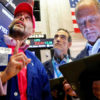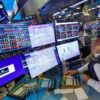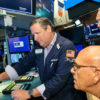
Why the jobs report could give the junk-bond market a second wind
Friday’s jobs report could prove pivotal to a high-yield corporate bond market that’s already retraced lost ground since Monday amid rising expectations for more monetary stimulus.
Corporate debt rated below investment-grade, or so-called junk bonds, have made significant gains this week on surging expectations that the Federal Reserve will cut rates to help give steam to an economy shadowed by the prospects for a global trade war. Against this tense backdrop, the jobs report could energize bets for easier Fed policy and spur a further rally for bonds from leveraged issuers.
The recent strength in high-yield may reflect “expectations for a reflationary Fed and the belief that risky assets should benefit at some point,” said Gary Pzegeo, head of fixed income at CIBC U.S. Private Wealth Management, in an interview.
See: Fed typically ‘cuts swiftly and does not disappoint market expectations,’ says BAML
Inflows into the biggest exchange-traded fund tracking the performance of high-yield corporate bonds surged on Wednesday, after struggling with redemptions in the past few sessions. The iShares iBoxx $ High Yield Corporate Bond ETF JNK, +0.25% attracted $1.51 billion of inflows on Wednesday, after shedding around $2.31 billion of assets in the five sessions since May 29, FactSet data show.
Rising prices for high-yield corporate debt, and lower yields, have helped narrow the premium investors pay to own junk bonds over risk-free Treasurys TMUBMUSD10Y, -0.64% over the last two days. The high-yield credit spread traded at 4.48 percentage points on Wednesday, narrowing from a high of 4.70 percentage points on Monday. Bond prices move in the opposite direction of yields.
Still, credit spreads remain substantially wider than their recent low of 3.64 percentage points on April 16, based on an index provided by ICE Data Services.
Read: Junk bond canary soothes fears around yield curve recession signal
In particular, market participants focused on remarks by Federal Reserve Chairman Jerome Powell on Tuesday, suggesting that the central bank could ease policy if trade tensions threatened the economic expansion. Fed Gov. Lael Brainard and Vice Chairman Richard Clarida echoed Powell’s views this week.
Traders in the fed fund futures market subsequently baked in a 70% chance of at least one cut by the Fed’s July meeting and a nearly 100% chance of at least one cut by the end of this year.
Stocks were also buoyed on expectations for rate cuts. The S&P 500 SPX, +0.61% and the Dow Jones Industrial Average DJIA, +0.71% are both up more than 3% this week, after suffering their worst May since 2010.
Economists polled by MarketWatch said they expect the U.S. economy to add 185,000 new jobs in May.
Yet some analysts have said nonfarm payrolls could disappoint after the ADP private-sector payrolls tumbled to 27,000 in May, a nine-year low. That said, they cautioned that the ADP report has historically been a poor predictor of the nonfarm payrolls numbers.
For junk bonds, a weaker-than-expected jobs reading might just be the tonic the sector needs for a more sustained rally.
“If jobs start to go to 100k or below, it could possibly force the hands of the Fed sooner,” Thanos Bardas, portfolio manager at Neuberger Berman, told MarketWatch.
“The labor market will be the key gauge for the Fed as it decides what adjustments to make to monetary policy,” said Bardas.
Lower borrowing rates can benefit debt-laden companies that finance their businesses in the junk bond market, such as California utility Pacific Gas & Electric Corp. PCG, +1.06% and Teva Pharmaceutical TEVA, -1.26%
But many junk-rated companies also need a tailwind from a strong U.S. economy and global trade to sustain their businesses and keep up with interest payments.
“The jobs report is obviously an important indicator for the health of the U.S. economy, but unfortunately the U.S. economy in isolation is not the only thing we have to worry about,” said Maura Murphy, a co-portfolio manager of Loomis Sayles’ inflation-protected securities and multiasset income funds, in an interview.
“We have to worry about the broader global picture. The global fears may dominate more than the U.S. jobs data,” Murphy said.
Check out: How stock-market bulls are adjusting to the reality of a messy U.S.-China trade war
To be sure, predicting Fed policy can be trickier than finding the right bonds to buy at the right price.
“There is no doubt that some degree of a price cut is being priced in,” Michael Terwilliger, a portfolio manager at Resource Credit Income, told MarketWatch. “It’s not fully risk-on. There is a degree of caution on lower-rated credit. But yes, I think the market is banking on cuts.”

















